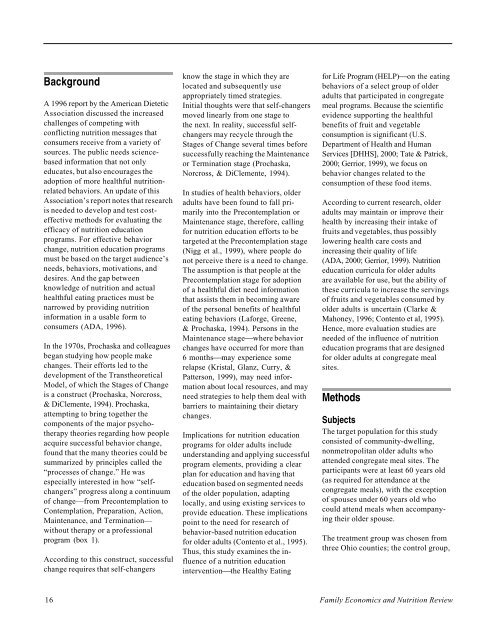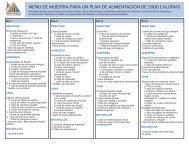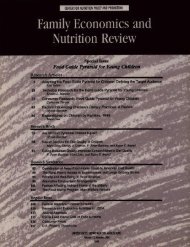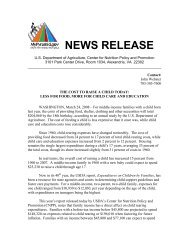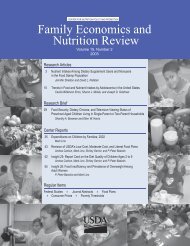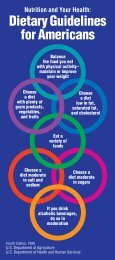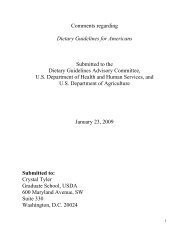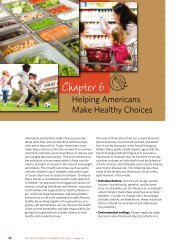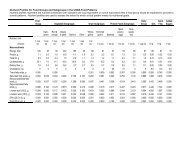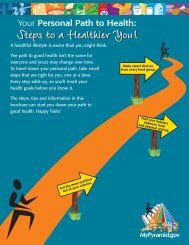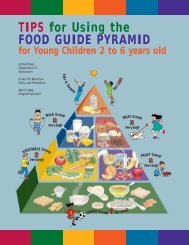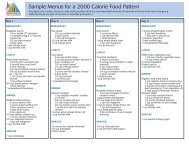Elderly Nutrition - Center for Nutrition Policy and Promotion - US ...
Elderly Nutrition - Center for Nutrition Policy and Promotion - US ...
Elderly Nutrition - Center for Nutrition Policy and Promotion - US ...
You also want an ePaper? Increase the reach of your titles
YUMPU automatically turns print PDFs into web optimized ePapers that Google loves.
Background<br />
A 1996 report by the American Dietetic<br />
Association discussed the increased<br />
challenges of competing with<br />
conflicting nutrition messages that<br />
consumers receive from a variety of<br />
sources. The public needs sciencebased<br />
in<strong>for</strong>mation that not only<br />
educates, but also encourages the<br />
adoption of more healthful nutritionrelated<br />
behaviors. An update of this<br />
Association’s report notes that research<br />
is needed to develop <strong>and</strong> test costeffective<br />
methods <strong>for</strong> evaluating the<br />
efficacy of nutrition education<br />
programs. For effective behavior<br />
change, nutrition education programs<br />
must be based on the target audience’s<br />
needs, behaviors, motivations, <strong>and</strong><br />
desires. And the gap between<br />
knowledge of nutrition <strong>and</strong> actual<br />
healthful eating practices must be<br />
narrowed by providing nutrition<br />
in<strong>for</strong>mation in a usable <strong>for</strong>m to<br />
consumers (ADA, 1996).<br />
In the 1970s, Prochaska <strong>and</strong> colleagues<br />
began studying how people make<br />
changes. Their ef<strong>for</strong>ts led to the<br />
development of the Transtheoretical<br />
Model, of which the Stages of Change<br />
is a construct (Prochaska, Norcross,<br />
& DiClemente, 1994). Prochaska,<br />
attempting to bring together the<br />
components of the major psychotherapy<br />
theories regarding how people<br />
acquire successful behavior change,<br />
found that the many theories could be<br />
summarized by principles called the<br />
“processes of change.” He was<br />
especially interested in how “selfchangers”<br />
progress along a continuum<br />
of change—from Precontemplation to<br />
Contemplation, Preparation, Action,<br />
Maintenance, <strong>and</strong> Termination—<br />
without therapy or a professional<br />
program (box 1).<br />
According to this construct, successful<br />
change requires that self-changers<br />
know the stage in which they are<br />
located <strong>and</strong> subsequently use<br />
appropriately timed strategies.<br />
Initial thoughts were that self-changers<br />
moved linearly from one stage to<br />
the next. In reality, successful selfchangers<br />
may recycle through the<br />
Stages of Change several times be<strong>for</strong>e<br />
successfully reaching the Maintenance<br />
or Termination stage (Prochaska,<br />
Norcross, & DiClemente, 1994).<br />
In studies of health behaviors, older<br />
adults have been found to fall primarily<br />
into the Precontemplation or<br />
Maintenance stage, there<strong>for</strong>e, calling<br />
<strong>for</strong> nutrition education ef<strong>for</strong>ts to be<br />
targeted at the Precontemplation stage<br />
(Nigg et al., 1999), where people do<br />
not perceive there is a need to change.<br />
The assumption is that people at the<br />
Precontemplation stage <strong>for</strong> adoption<br />
of a healthful diet need in<strong>for</strong>mation<br />
that assists them in becoming aware<br />
of the personal benefits of healthful<br />
eating behaviors (La<strong>for</strong>ge, Greene,<br />
& Prochaska, 1994). Persons in the<br />
Maintenance stage⎯where behavior<br />
changes have occurred <strong>for</strong> more than<br />
6 months⎯may experience some<br />
relapse (Kristal, Glanz, Curry, &<br />
Patterson, 1999), may need in<strong>for</strong>mation<br />
about local resources, <strong>and</strong> may<br />
need strategies to help them deal with<br />
barriers to maintaining their dietary<br />
changes.<br />
Implications <strong>for</strong> nutrition education<br />
programs <strong>for</strong> older adults include<br />
underst<strong>and</strong>ing <strong>and</strong> applying successful<br />
program elements, providing a clear<br />
plan <strong>for</strong> education <strong>and</strong> having that<br />
education based on segmented needs<br />
of the older population, adapting<br />
locally, <strong>and</strong> using existing services to<br />
provide education. These implications<br />
point to the need <strong>for</strong> research of<br />
behavior-based nutrition education<br />
<strong>for</strong> older adults (Contento et al., 1995).<br />
Thus, this study examines the influence<br />
of a nutrition education<br />
intervention⎯the Healthy Eating<br />
<strong>for</strong> Life Program (HELP)⎯on the eating<br />
behaviors of a select group of older<br />
adults that participated in congregate<br />
meal programs. Because the scientific<br />
evidence supporting the healthful<br />
benefits of fruit <strong>and</strong> vegetable<br />
consumption is significant (U.S.<br />
Department of Health <strong>and</strong> Human<br />
Services [DHHS], 2000; Tate & Patrick,<br />
2000; Gerrior, 1999), we focus on<br />
behavior changes related to the<br />
consumption of these food items.<br />
According to current research, older<br />
adults may maintain or improve their<br />
health by increasing their intake of<br />
fruits <strong>and</strong> vegetables, thus possibly<br />
lowering health care costs <strong>and</strong><br />
increasing their quality of life<br />
(ADA, 2000; Gerrior, 1999). <strong>Nutrition</strong><br />
education curricula <strong>for</strong> older adults<br />
are available <strong>for</strong> use, but the ability of<br />
these curricula to increase the servings<br />
of fruits <strong>and</strong> vegetables consumed by<br />
older adults is uncertain (Clarke &<br />
Mahoney, 1996; Contento et al, 1995).<br />
Hence, more evaluation studies are<br />
needed of the influence of nutrition<br />
education programs that are designed<br />
<strong>for</strong> older adults at congregate meal<br />
sites.<br />
Methods<br />
Subjects<br />
The target population <strong>for</strong> this study<br />
consisted of community-dwelling,<br />
nonmetropolitan older adults who<br />
attended congregate meal sites. The<br />
participants were at least 60 years old<br />
(as required <strong>for</strong> attendance at the<br />
congregate meals), with the exception<br />
of spouses under 60 years old who<br />
could attend meals when accompanying<br />
their older spouse.<br />
The treatment group was chosen from<br />
three Ohio counties; the control group,<br />
16 Family Economics <strong>and</strong> <strong>Nutrition</strong> Review


